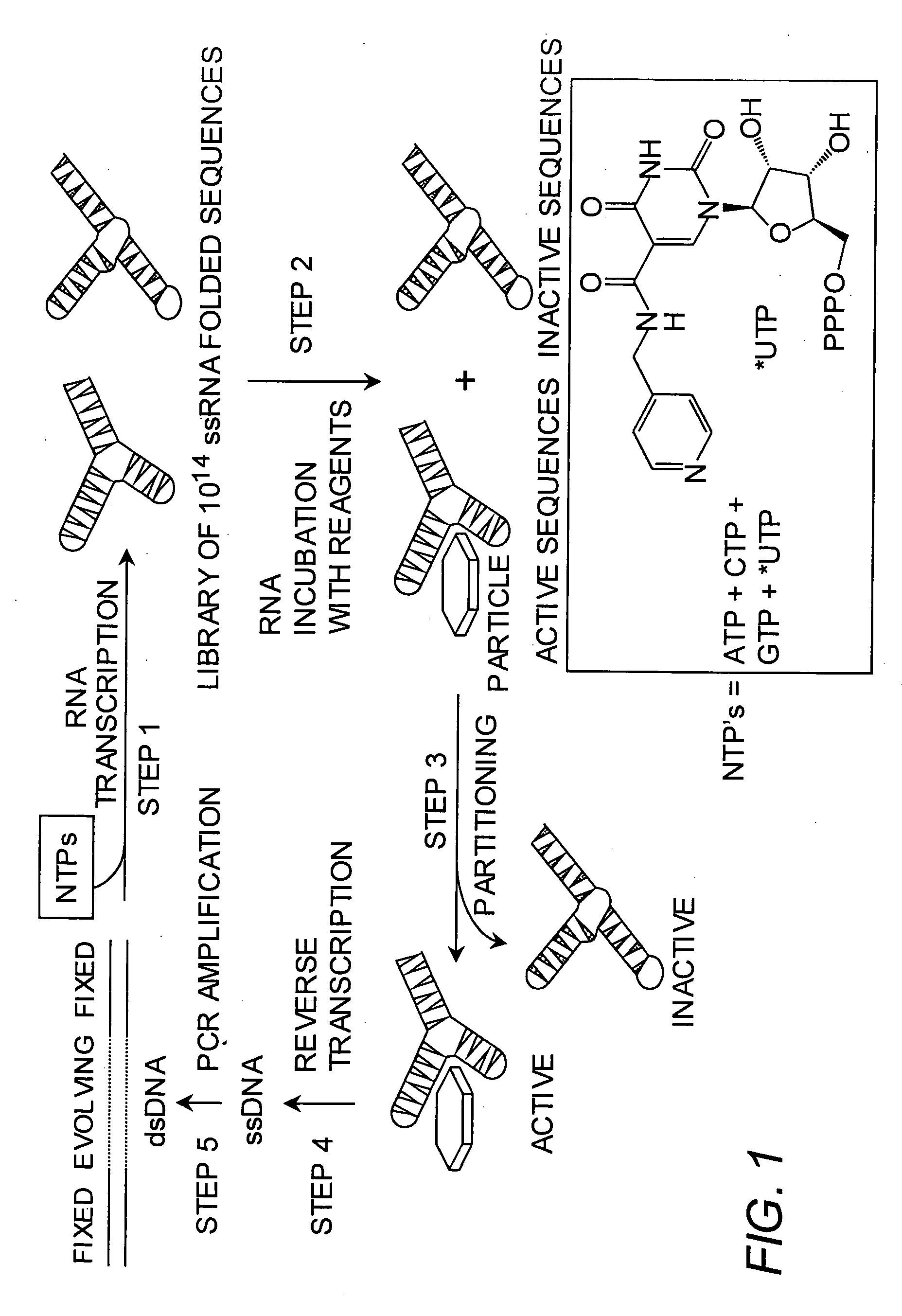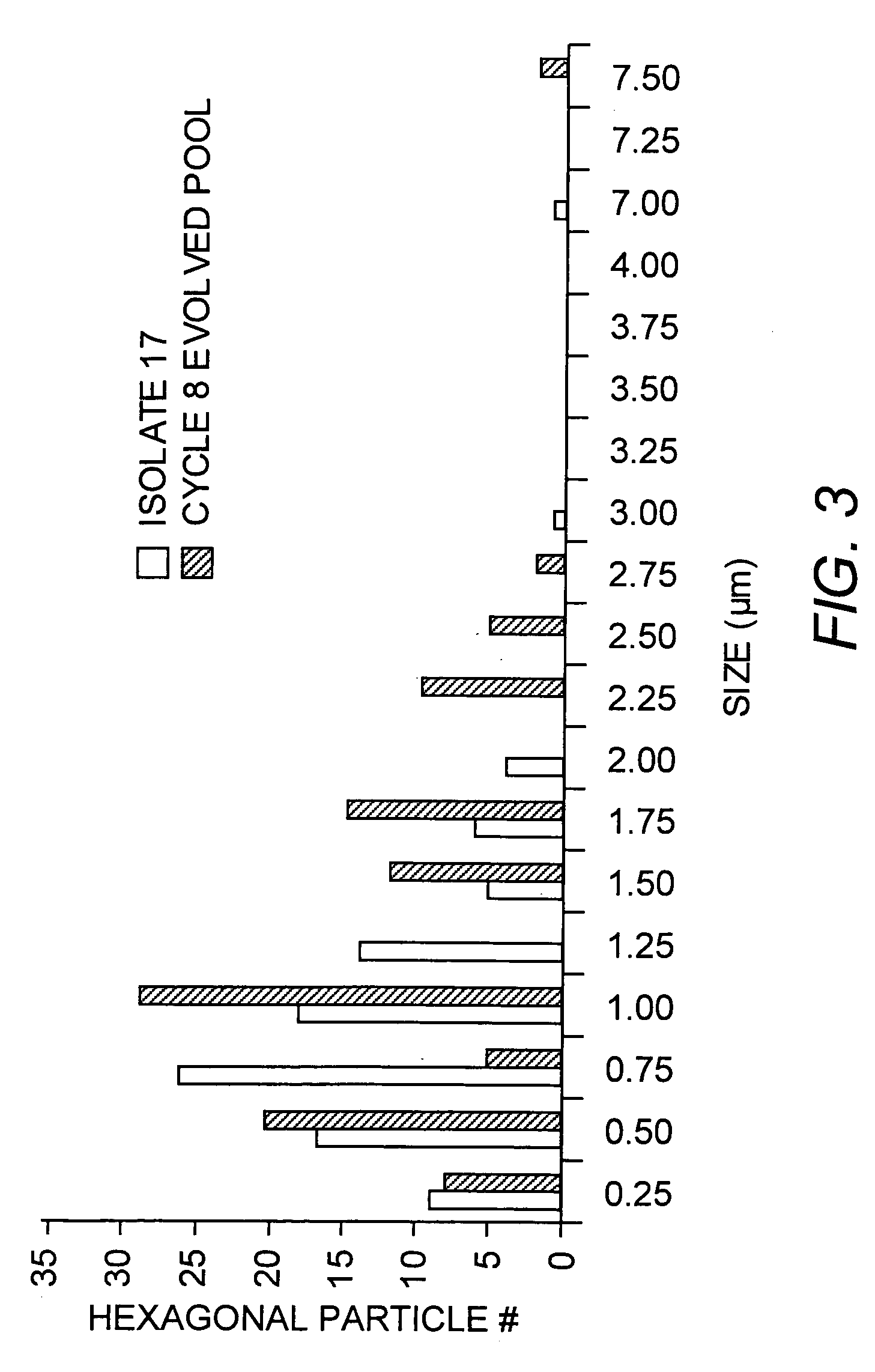Novel methods of inorganic compound discovery and synthesis
- Summary
- Abstract
- Description
- Claims
- Application Information
AI Technical Summary
Benefits of technology
Problems solved by technology
Method used
Image
Examples
example 1
Synthesis of Magnetic Plates
[0112] This Example describes the use of modified RNA libraries with enhanced metal binding affinity for inorganic particle formation. A modified RNA library was generated to select for RNA molecules with enhanced metal binding. The selection cycle used for discovering RNA-mediated crystal growth is shown in FIG. 1. The selection began with a chemically-synthesized (ABI 391) library of 1014 unique ssDNA sequences, 87 bp in length, containing a center region of 40 bp, random in sequence and flanking sequences which were specific for T7 RNA polymerase priming. Two cycle PCR was used to generate a dsDNA library. In step 1, T7 RNA polymerase was used to transcribe the dsDNA library into a ssRNA library containing ca. 1014 sequences. During step 1,5-(4-pyridylmethyl)-UTP (*UTP) was used to provide additional metal coordination sites beyond the heterocyclic nitrogens present in native RNA. As an alternative, a modified CTP analog could be used. In step 2, the ...
example 2
Synthesis of Cobalt-Iron Oxide Particles
[0120]FIG. 4 shows the in vitro selection scheme used to synthesize and identify cobalt-iron oxide compounds having properties of interest, including cobalt-iron oxide spheres, cubes and fibers (including magnetic cobalt-iron oxides), as well as to identify functional RNA molecules involved in the formation of such cobalt-iron oxide compounds. A random ssDNA pool of 1014 molecules with different sequences was used in the selection cycles. The pool contained chemically-synthesized ssDNA (Invenex, Inc., Denver, Colo.) of 87-bp in length with a 40-bp long random region in the middle, flanked by defined sequences to allow for primer binding and enzymatic reactions applied in selection procedures. A pool of dsDNA, equivalent to the library of ssDNA pool, was generated by performing two cycles of PCR on the random ssDNA. In Step 1, two sets of complementary ssRNA pools were created by in vitro transcriptions. The ssRNA molecules were produced by in...
example 3
[0128] The invention can be practiced to synthesize a methanol oxidation catalyst and to identify ss nucleic acids that can form a methanol oxidation catalyst. Materials for oxidizing methanol at low over-potentials are of interest for direct methanol fuel cells. Methanol oxidation is kinetically slow because it requires the removal of 6 electrons in the overall reaction
CH3OH+H2O→6H++CO2+6e− (1)
[0129] The best known methanol oxidation catalysts are alloys of mid-transition row elements such as Pt, Ru, Os, Rh, and Ir. A highly active quarternary alloy was discovered recently by Mallouk (Sun et al. (2001) Anal. Chem. 73: 1599-1604; Reddington et al., (1998) Science, 280: p. 1735-1737) using a method in which catalysts of varying composition were printed from an ink-jet printer onto carbon electrodes. To find this material, a library of over 600 compositions was screened simultaneously. The most active catalyst was comprised of Pt(44) / Ru(40) / Os(10) / Ir(5) (num...
PUM
| Property | Measurement | Unit |
|---|---|---|
| Length | aaaaa | aaaaa |
| Size | aaaaa | aaaaa |
| Size | aaaaa | aaaaa |
Abstract
Description
Claims
Application Information
 Login to View More
Login to View More - R&D
- Intellectual Property
- Life Sciences
- Materials
- Tech Scout
- Unparalleled Data Quality
- Higher Quality Content
- 60% Fewer Hallucinations
Browse by: Latest US Patents, China's latest patents, Technical Efficacy Thesaurus, Application Domain, Technology Topic, Popular Technical Reports.
© 2025 PatSnap. All rights reserved.Legal|Privacy policy|Modern Slavery Act Transparency Statement|Sitemap|About US| Contact US: help@patsnap.com



